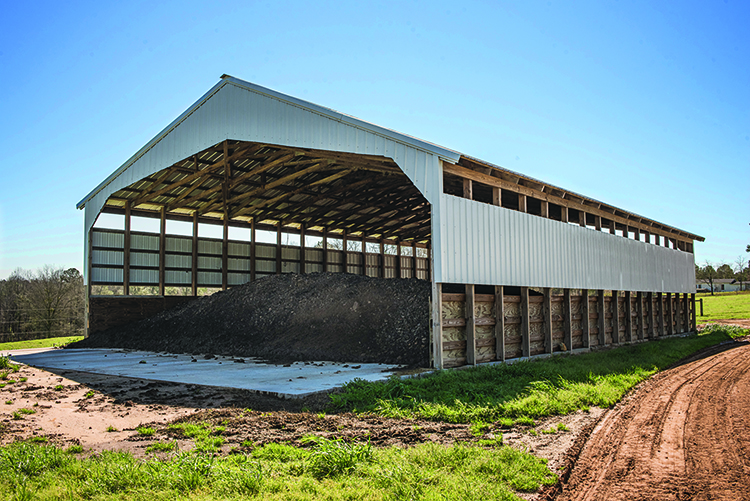The author is an assistant professor and extension specialist in nutrient and waste management at the University of Idaho.

According to the Food and Agriculture Organization (FAO), soil health is defined as the continued capacity of soil to function as a vital living system, within ecosystem and land-use boundaries, to sustain biological productivity, promote the quality of air and water environments, and maintain plant, animal, and human health. For cropland, this definition can be interpreted as the continued capacity of soil to function as a vital living system to sustain healthy crop production.
One proven way to improve soil health is to elevate soil carbon and soil organic matter. The reason no-tillage practices and cover crops improve soil health is by reducing carbon loss or increasing it through photosynthesis, respectively. Manure and compost application can also boost soil carbon because these products are high in organic carbon.
Manure and compost have long been critical components of crop fertility plans worldwide. The high concentration of organic carbon and plant-essential nutrients in manure and compost make them excellent fertilizers. However, manure is greatly underutilized; only about 22% of the manure produced worldwide is applied as fertilizer.
This underutilization can yield regional nutrient imbalances when inorganic fertilizers are imported to meet crop nutrient needs that locally produced fertilizers (such as manure and compost) could supply. However, with this challenge comes opportunity.
An important contributor to overall soil health is soil biology, and it makes up part of the “living ecosystem” piece of the definition. Fauna inhabiting soil affect and are related to many physical and chemical characteristics critical to crop production.
Soil bacteria and fungi form the base of the soil ecosystem. These organisms both create soil organic matter and are part of soil organic matter. Thus, they are a critical component of healthy soil.
Soil bacteria and fungi consume organic matter as well as animal and plant residues (including manure, compost, crop stubble, and so forth), which helps to cycle nutrients in soil. Manure and compost applications have been shown to increase bacterial and fungal populations in soils when compared with inorganic fertilizers.
Some manure or compost is better than none. When only half of required crop nitrogen is supplied by manure, with the other half supplied by inorganic fertilizer, fungal and bacterial populations continue to grow.
Applications make “cents”
For crop producers, fertilizer costs generally encompass a relatively large proportion of input costs. In modern crop production, virtually all crops receive fertilizer to ensure ample yields.
In several studies comparing manure and/or compost with inorganic fertilizers where the same rates of nutrients were applied, more nitrogen, phosphorous, and potassium were available to crops with manure and compost. This improved availability can generally be linked to extra microbial activity.
When abundant populations of soil biology are present, like in soils receiving compost and manure, nutrient cycling tends to rise because microbes are feeding on each other, soil organic matter, and animal and plant residues. More microbes necessitate more feeding, and thus, more nutrient cycling. This means that growers can potentially reduce fertilizer applications by leveraging the free work done by microbes when better food sources (those containing carbon) are provided.
Larger biological populations also improve soil physical properties. Some soil organisms help “glue” soil mineral particles together through by-product production, while other soil organisms “tie” particles together with hyphae. Both processes help improve soil structure by creating more space for water and air exchange because, just like humans and other living things, soil microbiology needs air and water to survive. This leads to further growth in soil microbial populations due to a better habitat.
Manure and compost application have also been shown to improve soil structural properties, like aggregate stability and infiltration, when compared to inorganic fertilizer. This is likely due to both enhanced soil biology and more in soil organic carbon. Regardless of the cause, as soil structure improves, water from irrigation and rainfall can better infiltrate into the soil, and soil and nutrients are also less likely to run off.
Incorporate manure and compost
Just like care should be taken when first deciding to implement cover crops and no-tillage, care should be taken when utilizing manure and compost.
Improvement in soil health metrics has been shown with any species of manure and compost. However, farms must ensure that manure and compost are applied at agronomically appropriate rates. This means that growers need to know what nutrients they are applying through laboratory testing as well as what their soil nutrient status is and what nutrients the crop needs.
Application of manure and/or compost creates a win-win-win situation by enhancing soil health, growing a similarly yielding crop, and reducing regional nutrient imbalances. If you’re in an area where manure and/or compost is available, I urge you to determine whether these products would fit into your system. They are not waste products and, in fact, have a lot of worth.
This article appeared in the May 2021 issue of Journal of Nutrient Management on pages 12-13.
Not a subscriber? Click to get the print magazine.




